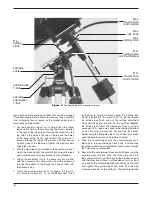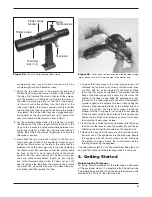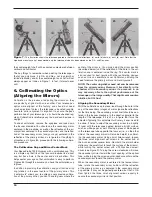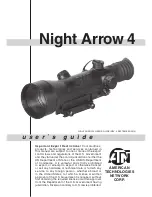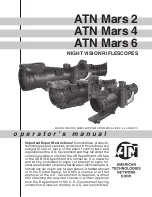
4
faces have delicate coatings on them that can be damaged
if touched inappropriately. Never remove any lens assembly
from its housing for any reason, or the product warranty and
return policy will be voided.
1. Lay the equatorial mount on its side. Attach the tripod
legs one at a time to the mount using the screws installed
in the tops of the tripod legs. Remove the screw from the
leg, line up the holes in the top of the leg with the holes
in the base of the mount, and reinstall the screw so it
passes through the leg and the mount with one washer
on both sides of the tripod leg. Tighten the wingnuts only
finger-tight, for now.
2. With the tripod legs now attached to the equatorial mount,
stand the tripod upright (be careful!) and spread the legs
apart until the accessory tray bracket is fully extended.
3. Attach the accessory tray to the accessory tray bracket
with the accessory tray wing screws. Push the screws up
through the bottom of the bracket and thread them into
the accesory tray.
4. Orient the equatorial mount as it appears in Figure 2,
at a latitude of about 40°, i.e., so the pointer next to the
latitude scale (located directly above the latitude lock
T-bolt) is pointing to the mark at “40.” To do this, loosen
the latitude lock T-bolt, and turn the latitude adjustment
T-bolt until the pointer and the “40” line up. Then retighten
the latitude lock T-bolt. The declination (Dec.) and right
ascension (R.A.) axes may need re-positioning (rotation)
as well. Be sure to loosen the RA and Dec. lock knobs
before doing this. Retighten the R.A. and Dec. lock knobs
once the equatorial mount is properly oriented.
5. Slide the counterweight onto the counterweight shaft.
Make sure the counterweight lock knob is adequately
loosened to allow the counterweight shaft to pass through
the hole in the counterweight.
6. Now, with the counterweight lock knob still loose, grip the
counterweight with one hand and thread the shaft into
the equatorial mount (at the base of the declination axis)
with the other hand. When it is threaded as far in as it will
go, position the counterweight about halfway up the shaft
and tighten the counterweight lock knob. The retaining
screw and washer on the bottom of the shaft prevent the
Figure 2.
The SpaceProbe 130’s equatorial mount.
RIG
hT
ASCENSION
Ax
IS
R.A.
setting-circle
lock thumbscrew
D
ECLINA
TION
A
xIS
Dec.
slow-motion
control cable
Dec.
lock knob
Dec.
setting-circle
R.A.
slow-motion
control cable
R.A.
setting
circle
Latitude
scale
Latitude lock
T-bolt
Latitude
adjustment
T-bolt




